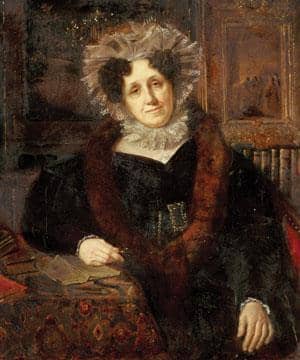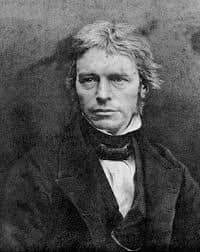How in the world would doing drugs lead to success? And what is the arc lamp and how is that related to this whole mess? Well, I’ll tell you and along the way I will talk about early 1800s drug parties, science superstars, giant stinky batteries, and chemistry “for the female sex”.
Table of Contents
Humphry Davy’s Childhood
Humphry Davy and Laughing Gas
Humphry Davy and the Royal Society
Humphry Davy and the Giant Stinky Battery
Humphry Davy and the Arc Lamp
Women in Science: Jane Marcet
How Humphry Davy Met Michael Faraday
Video Script Download
Davy’s Childhood

Humphry Davy was born in Cornwall, England to a farmer and woodcarver.
Davy lived in genteel poverty, with enough money for Humphry to go to local school but not more advanced without help from his godfather. His brother described their upbringing as having “little taste for literature, and still less for science, instead they all delighted in hunting, shooting, wrestling cockfighting, all ending in drunkenness”.
When Davy was 16 years old, his father died and his godfather got him a “job” as an indentured servant to a local surgeon and apothecary.
The plan was for Davy to study to become a doctor himself.
Meanwhile, he self taught and worked at the pharmacy.
Davy started to study chemistry, “merely as a branch of his professional knowledge.” Pretty soon he was hooked, causing his boss to complain, “This boy Humphry is incorrigible. He will blow us all into the air.”
Davy and Laughing Gas

Meanwhile, the drug “nitrous oxide” or laughing gas had been discovered.
A man named Thomas Beddoes decided that it might be good for people with lung problems! (No one thought of using it as a painkiller for a further 50 years).
Anyway, Beddoes started a “Pneumatic Institute” and he decided to hire Humpry Davy to assist him.
At the Institute, Davy diligently conducted experiments on himself, his friends and all types of animals.
Pretty soon a group of doctors, patients, scientists and poets were meeting at the Institute every night to studiously “experiment” with this drug. It was especially popular with the poets like Samuel Coleridge and William Wordsworth.
Another poet named Robert Southey wrote, “Such a gas has Davy discovered, the gaseous oxide! I have had some; it made me laugh and tingle in every toe and fingertip.
Davy has actually invented a new pleasure for which language has no name”. (Davy didn’t invent laughing gas, nor did he pretend to, but often people forgot, especially after using the drug)
Anyway, Davy produced a huge 580-page book on nitrous oxide.
Almost immediately, nitrous oxide was used at “laughing gas” parties.
It continued to be a prominent feature in both upper class events and traveling “science shows” for the masses for almost one hundred years.
For the upper crust of England, the handsome young Davy was the master of ceremonies (and a prolific practitioner) for an astonishing new drug. Bristol, and the Pneumatic Institute, was not big enough for this rising new star. It was time to go to London.
Davy and the Royal Society

In 1799, a wealthy Englishman got together with his titled friends to create a new science institute in London, called the Royal Institution. The endless war with Napoleon in France had landlocked many Englishmen from their international science pursuits and he wanted a place for research, giving talks and for, “exciting a taste for science amongst the higher ranks.”
The original fifty-eight members were Dukes, Barons, members of parliament, and, basically, every high ranking man in England who was interested in science. And they had an opening for a Chemist and lecturer.
Davy’s most important job was to give interesting lectures.
In 1800, Davy gave his first public lecture in London on the hot topic of the day: galvanism or reanimating dead animals with electricity. It was an instant success of grand proportions.
From then on, when he gave his talks, they had to make the street in front of the building one way to help with traffic!
Davy was not just lecturing, he was also a prolific researcher.
He studied Geology and Agriculture with the same zeal as Chemistry publishing paper after paper (but carefully not interrupting his busy social life with immense amounts of laughing gas or his avid fly fishing). Frankly, it is exhausting just reading about him.
Davy and the Giant Stinky Battery

Meanwhile, in the same year that Davy started his lectures at the Royal Institution, an Italian man named Alessandro Volta found that if you stacked layers of zinc and silver (or zinc and copper) with thin cardboard soaked in saltwater it would produce continual electricity.
In other words, Volta invented the battery.
A Scotsman turned Volta’s invention on its side and put plates of copper and zinc in a rectangular box or trough that was filled with sulfuric acid and water.
This was better then Volta’s battery as the acid was stronger then the salt water and putting on it’s side meant that you could use as many plates as you wanted without the weight of the metal squishing all the saltwater out of the cardboard.
Davy decided to use this “trough” battery to make the biggest battery in the world! He filled over 880 square feet of the basement of the Institute with 2,000 plates of copper and zinc and unmeasured gallons of acid. Supposedly, it produced some off gasses and smelled just awful!
Why would a chemist want a big stinky battery? Well, it turns out that that the voltage from a battery can rip molecules in a liquid apart and produce gasses of pure elements.
In fact, when Volta first invented the battery, scientists had accidentally noticed that if you put the ends of wire from a battery into water then the ends would form bubbles of hydrogen and oxygen.
The difficulty was in creating a fluid that could be decomposed into new elements. When Davy succeeded in 1806, “he could not contain his joy – he actually bounded about the room in ecstatic delight.”
Davy then discovered 8 new elements and his lectures on his new discoveries cemented his place as one of the top scientists in England and possibly the world!
Davy and the Arc Lamp

While playing with his giant battery and chemicals, Davy noticed something strange, if the current went between two carbon rods that were touching, it would cause a spark.
If the rods were then slowly separated the spark would grow bigger and create a constant and brilliantly strong light! In this way he could get a 4-inch long painfully bright lamp with electricity.
In 1809 Davy first demonstrated his invention that he called an “arch lamp” as it made an arch of light but what quickly was called an arc lamp.
This was the first practical electric light, although only useful for outdoor or demonstration purposes as it was between 10 and 40 times brighter than a 100 W light bulb! Arc lamps were actually used for commercial lighting until it was replaced by the incandescent bulb.
Women in Science: Jane Marcet

A comment about women and science at this time.
Science was moving from the salons run by wealthy heiresses to the laboratories at places like the Royal Institution. For this reason, women were no longer involved in assisting experiments or promoting scientists.
However, they were allowed to join in on laughing gas parties (sometimes with the hope it would make them more agreeable to their husbands!).
Women were also allowed to attend science lectures and Davy was a leader in pushing for women’s education in science. One woman, Jane Marcet, who attended many of Davy’s lectures, was initially confused by them.
She then asked her husband for help to understand the basics and felt like it made Davy’s talks much more rewarding. For that reason, she wrote an introduction to Chemistry book, “intended most especially for the female sex” based on the Chemistry in Humphry Davy’s lectures.
Although the book was written for women, it was highly popular with men too, especially those from lower class backgrounds, as you didn’t need to read Latin or have a formal education to understand it.
In fact, this was one of the first elementary science textbooks ever written! In 1810, Marcet’s book ended up in a bookstore in London and a young bookbinder’s apprentice named Michael Faraday happened to read it.
In later years Faraday credited Jane Marcet’s book with teaching him how to experiment with Chemistry! I will talk a lot more about Faraday in the next video.
How Davy Met Faraday

Anyway, back to Humpry Davy. In October of 1812, Davy had an accident in the laboratory.
He was leaning over a container of chemicals and it exploded and severely damaged his eye.
According to his brother, it is surprising that he didn’t have more injuries, as Davy was an excited and disorganized experimenter and, “exposure to danger was an everyday occurrence. “
It took Davy a few months to recover and therefore he needed an assistant. Davy ended up hiring Michael Faraday to help out (the same person who I mentioned had started experimenting with Chemistry because of Jane Marcet’s book).
Davy didn’t know it, but Faraday would soon eclipse him as one of the most innovative scientists the world has ever known.


Pingback: How The Light Bulb Was Invented And Who Invented It? - Kathy Loves Physics
Pingback: Why Doesn't The US Use 220V Like Everyone Else In The World? - Kathy Loves Physics